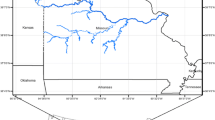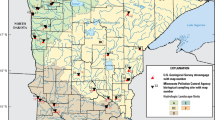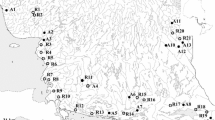Abstract
The relative influences of water quality and in-streamhabitat on receiving water biology were investigatedin the Little Miami River, Ohio, a national and statescenic river located in the southwest corner of thestate. Monitored sample data for water chemistry,habitat, invertebrates and fish were obtained fromfederal and state sources and integrated via ageographical information system (GIS), using a uniquestream segmenting system. Locations and flowinformation for municipal wastewater treatment plants(WWTPs) were also integrated into the system. Therelative importance of water chemistry and habitat onbiological sample information was determined usingmultivariate forward stepwise regression. Theprincipal environmental factors that influencedbiological responses were in-stream habitat andpercent cumulative WWTP effluent at mean flow. Cumulative WWTP effluent at low flow dilution,nutrients and total toxic units from metals andammonia did not correlate with biological responses(e.g. number of mayfly species, invertebrate communityindex (ICI), number of fish species and index ofbiotic integrity (IBI)). We found the GIS-based datamethods to be highly useful for understanding theprincipal processes that guide receiving water health.
Similar content being viewed by others
References
Draper, N.R. & H. Smith, 1981. Applied Regression Analysis, 2nd edition. Wiley, New York, NY.
EU, 1996. Technical guidance documents in support of the commission directive 93/67/EEC on risk assessment for new notified substances and the commission regulation (EC) 1488/94 on risk assessment for existing substances (Parts I–IV). Ispra, Italy, pp. 735.
Hall, L.W., S.A. Fischer, W.D. Killen, Jr., M.C. Scott, M.C. Ziegenfuss & R.D. Anderson, 1994. Status assessment in acid-sensitive and non-acid-sensitive Maryland coastal plain streams using an integrated biological, chemical, physical, and land-use approach. J. Aquat. Ecosys. Hlth. 3: 145–167.
Hall, L.W., M.C. Scott, W.D. Killen, Jr. & R.D. Anderson, 1996. The effects of land-use characteristics and acid sensitivity on the ecological status of Maryland coastal plain streams. Environ. Toxicol. Chem. 15: 384–394.
Lenat, D.R. & J.K. Crawford, 1994. Effects of land use on water quality and aquatic biota of three North Carolina Piedmont streams. Hydrobiologia 294: 185–199.
Ohio EPA, 1988. Biological criteria for the protection of aquatic life, volume 2: Users manual for biological field assessment of Ohio surface waters}. Ecological Assessment Section, State of Ohio Environmental Protection Agengy, Columbus, Ohio.
Ohio EPA, 1995a. Biological and water quality study of the Little Miami River and selected tributaries, volume 1. OEPA Technical Report MAS/1994-12-11, pp. 237.
Ohio EPA, 1995b. Associations between the aquatic biota, habitat, and nutrients in Ohio rivers ans streams. OEPA Technical Report MAS1995-4-1, July 27 draft, pp. 51.
Omernik, J.M., 1988. Ecoregions of the coterminous United States. Ann. Assoc. Amer. Geogr. 77: 118–125.
Rankin, E.T., 1989. The qualitative habitat evaluation index (QHEI): Rationale, methods and application. Division of Water Quality Planning and Assessment, Columbus, Ohio, pp. 54.
Ruse, L.P., 1996. Multivariate techniques relating macroinvertebrate and environmental data from a river catchment. Wat. Res. 30: 3017–3024.
SAS Institute Inc., 1989. SAS/STAT User’s Guide, Version 6, 4th edition, volume 2. SAS Institute Inc., Cary NC.
Touart, L.W., 1995. The federal insecticide, fungicide, and rodenticide act. In: G.M. Rand (ed.), Fundamentals of Aquatic Toxicology, 2nd edition (Chapter 21). pp. 657–668. Taylor & Francis, Washington, D.C.
U.S. EPA, 1984a. Ambient water quality criteria for: Cadmium. EPA 440/5-84-032, Washington, DC.
U.S. EPA, 1984b. Copper water quality standards criteria summaries: A compilation of state and federal criteria. EPA 440-588-027, Washington, DC.
U.S. EPA, 1984c. Ambient water quality criteria for: Lead. EPA 440/5-84-027, Washington, DC.
U.S. EPA, 1985. Ambient water quality criteria for: Ammonia. EPA 440/5-85-001, Washington, DC.
U.S. EPA, 1986. Ambient water quality criteria for: Nickel. EPA 440/5-86-004, Washington, DC.
U.S. EPA, 1987a. Ambient water quality criteria for: Silver. Draft 9/24/87. U.S. EPA Office of Research and Development, Duluth, MN.
U.S. EPA, 1987b. Ambient water quality criteria for: Zinc. EPA 440/5-87-003, Washington, DC.
U.S. EPA, 1988. State water quality standards summary: Ohio. EPA 440/5 88-070, Washington, DC.
U.S. E.P.A., 1989. Report to Congress: 1988 NEEDS Survey: Assessment of needed publicaly owned wastewater treatment facilities in the United tates. EPA 430/8-89-001. Washington, D.C.
U.S. E.P.A., Region IX, 1992. STORET Documentation for Menu-Driven User Interface. EPA 68-C9-0013. San Francisco, California.
U.S. E.P.A., 1993. Permit Compliance System User Documentation Master Index. PCS-MA93-1.01. Washington, D.C.
Walker, J.D., 1995. Toxic substance control act (TSCA) interagency testing committee: Data developed under section 4 of TSCA. In: G.M. Rand (ed.), Fundamentals of Aquatic Toxicology, 2nd edition. pp. 669–701. Taylor & Francis, Washington, D.C.
Wichert, G.A., 1995. Effects of improved sewage effluent management and urbanization on fish associations of Toronto streams. N. Amer. J. Fish. Mgt. 15: 440–456.
Yoder, C.O. & E.T. Rankin, 1995. Biological response signatures and the area of degradation value: new tools for interpreting multimetric data. In: W.S. Davis & T. Somon (eds), Biological Assessment and Criteria: Tools for Water Resource Planning and Decision Making (Chapter 17). pp. 263–286. Lewis Publishers, Boca Raton
Author information
Authors and Affiliations
Rights and permissions
About this article
Cite this article
Dyer, S., White-Hull, C., Wang, X. et al. Determining the influence of habitat and chemical factors on instream biotic integrity for a Southern Ohio watershed. Journal of Aquatic Ecosystem Stress and Recovery 6, 91–110 (1997). https://doi.org/10.1023/A:1009957614818
Issue Date:
DOI: https://doi.org/10.1023/A:1009957614818




